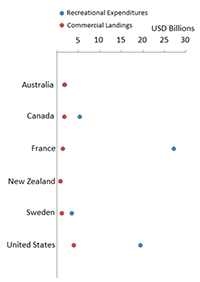Pêcheries
Recreational Fisheries
Introduction to recreational fisheries
Recreational fishing is a popular pastime in many countries. In salt or fresh water, recreational anglers use a number of traditional fishing techniques, from pole-and-line to nets to traps. While direct value-added of recreational fishing is small compared to commercial fishing, the amount of economic activity generated by recreational fishing can be large. The impact of this activity on rural communities where recreational fishing takes place can be important.
 A report written by Esther Regnier of Kiel University while interning at the OECD examines the value of recreational fishing. In many cases expenditures by recreational fishers exceed the value of commercial landings. In France and the United States, researchers estimated that recreational expenditures were several time larger than the value of landings. While these numbers aren’t directly comparable, they are often pointed to as a reason to give increased access to recreational fishers.
A report written by Esther Regnier of Kiel University while interning at the OECD examines the value of recreational fishing. In many cases expenditures by recreational fishers exceed the value of commercial landings. In France and the United States, researchers estimated that recreational expenditures were several time larger than the value of landings. While these numbers aren’t directly comparable, they are often pointed to as a reason to give increased access to recreational fishers.
Commercial and recreational fisheries often exploit the same fish stock and can be in competition with each other. Ragnar Arnasson of the University of Iceland re-examined the classical analysis of fish stock management by taking into account the activities of recreational fishers. He showed that fisheries managers should take both kinds of fishing into account when setting fishing quotas, and that allowing commercial and recreational fishers to trade fishing opportunities can be a good idea.
However, incorporating recreational fishing into stock management is harder than it seems at first glance. Recreational catch is poorly measured and controlling it is equally difficult. Anglers also value the experience of fishing more than the catch itself, so trading harvest quota among commercial and recreational fishers isn’t an obvious process. Josh Abbot of Arizona State University took a look at the complexities of this and concluded that it is better to start with improved collection of data and encouraging recreational fishers to organize themselves in groups that are better equipped to negotiate and trade in fishing rights.
There is no obviously correct way to allocate fish between recreational and commercial fishers from an economic perspective. This leaves it up to the fisheries manager to find pragmatic approaches that recognize the valid interests of different stakeholders.
Relevant OECD work
 |
 |
| OECD Handbook for Fisheries Managers | OECD Review of Fisheries: Country Statistics |
Further reading
- Regnier, E (2013), Recreational Fisheries
- Arnassson, R (2012), Managing Commercial and Recreational Fisheries: Issues and challenges
- Abbot, J (2013), Integrating Recreational Fisheries into Fisheries Management: Challenges and Opportunities
OECD Statistics
Documents connexes